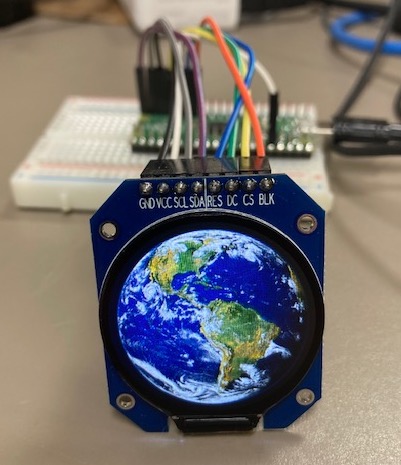This driver is based on devbis' st7789_mpy driver. I modified the original driver for one of my projects to add:
- Display Rotation.
- Scrolling
- Writing text using bitmaps converted from True Type fonts
- Drawing text using 8 and 16 bit wide bitmap fonts
- Drawing text using Hershey vector fonts
- Drawing JPG's, including a SLOW mode to draw jpg's larger than available ram using the TJpgDec - Tiny JPEG Decompressor R0.01d. from http://elm-chan.org/fsw/tjpgd/00index.html
Included are 12 bitmap fonts derived from classic pc text mode fonts, 26 Hershey vector fonts and several example programs for different devices. The driver supports 240x240 displays.
Documentation can be found in the docs directory and at https://russhughes.github.io/gc9a01_mpy/
The firmware directory contains pre-compiled firmware for various devices with the gc9a01 C driver and frozen python font files. See the README.md file in the fonts folder for more information on the font files.
- ARDUINO_NANO_ESP32
- ESP32_GENERIC with 4, 8, 16, or 32MB flash
- ESP32_GENERIC_C3 with 4, 8, 16, or 32MB flash
- ESP32_GENERIC_S2 with 4, 8, 16, or 32MB flash
- ESP32_GENERIC_S3 with 4, 8, 16, or 32MB flash
- LILYGO_TTGO_LORA32
- LOLIN_C3_MINI
- LOLIN_S2_MINI
- LOLIN_S2_PICO
- M5STACK_ATOM
- OLIMEX_ESP32_POE
- SIL_WESP32
- UM_FEATHERS2
- UM_FEATHERS2NEO
- UM_FEATHERS3
- UM_NANOS3
- UM_PROS3
- UM_TINYPICO
- UM_TINYS2
- UM_TINYS3
- UM_TINYWATCHS3
- ADAFRUIT_ITSYBITSY_RP2040
- ADAFRUIT_QTPY_RP2040
- ARDUINO_NANO_RP2040_CONNECT
- ADAFRUIT_FEATHER_RP2040
- GARATRONIC_PYBSTICK26_RP2040
- NULLBITS_BIT_C_PRO
- PIMORONI_PICOLIPO_16MB
- PIMORONI_PICOLIPO_4MB
- PIMORONI_TINY2040
- RPI_PICO
- RPI_PICO_W
- SPARKFUN_PROMICRO
- SPARKFUN_THINGPLUS
- W5100S_EVB_PICO
- W5500_EVB_PICO
- WAVESHARE_RP2040_LCD_1.28
- WEACTSTUDIO
This is a work in progress.
-- Russ



